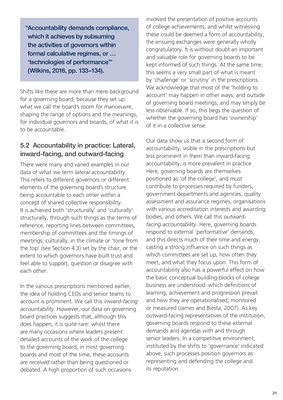
21
Shifts like these are more than mere background
for a governing board, because they set up
what we call the board's room for manoeuvre,
shaping the range of options and the meanings,
for individual governors and boards, of what it is
to be accountable.
5.2��Accountability�in�practice:�Lateral,�
inward-facing, and outward-facing
There were many and varied examples in our
data of what we term lateral accountability.
This refers to different governors or different
elements of the governing board's structure
being accountable to each other within a
concept of shared collective responsibility.
It is achieved both 'structurally' and 'culturally':
structurally, through such things as the terms of
reference, reporting lines between committees,
membership of committees and the timings of
meetings; culturally, in the climate or 'tone from
the top' (see Section 4.3) set by the chair, or the
extent to which governors have built trust and
feel able to support, question or disagree with
each other.
In the various prescriptions mentioned earlier,
the idea of holding CEOs and senior teams to
account is prominent. We call this inward-facing
accountability. However, our data on governing
board practices suggests that, although this
does happen, it is quite rare: whilst there
are many occasions where leaders present
detailed accounts of the work of the college
to the governing board, in most governing
boards and most of the time, these accounts
are received rather than being questioned or
debated. A high proportion of such occasions
involved the presentation of positive accounts
of college achievements, and whilst witnessing
these could be deemed a form of accountability,
the ensuing exchanges were generally wholly
congratulatory. It is without doubt an important
and valuable role for governing boards to be
kept informed of such things. At the same time,
this seems a very small part of what is meant
by 'challenge' or 'scrutiny' in the prescriptions.
We acknowledge that most of the 'holding to
account' may happen in other ways, and outside
of governing board meetings, and may simply be
less observable. If so, this begs the question of
whether the governing board has 'ownership'
of it in a collective sense.
Our data show us that a second form of
accountability, visible in the prescriptions but
less prominent in them than inward-facing
accountability, is more prevalent in practice.
Here, governing boards are themselves
positioned as 'of the college', and must
contribute to processes required by funders,
government departments and agencies, quality
assessment and assurance regimes, organisations
with various accreditation interests and awarding
bodies, and others. We call this outwardfacing accountability.
Here, governing boards
respond to external 'performative' demands,
and this directs much of their time and energy,
casting a strong influence on such things as
which committees are set up, how often they
meet, and what they focus upon. This form of
accountability also has a powerful effect on how
the basic conceptual building-blocks of college
business are understood: which definitions of
learning, achievement and progression prevail
and how they are operationalised, monitored
or measured (James and Biesta, 2007). As key
outward-facing representatives of the institution,
governing boards respond to these external
demands and agendas with and through
senior leaders. In a competitive environment,
instituted by the shifts to 'governance' indicated
above, such processes position governors as
representing and defending the college and
its reputation.
"�Accountability�demands�compliance,�
which�it�achieves�by�subsuming�
the activities of governors within
formal calculative regimes, or …
'technologies�of�performance'"�
(Wilkins,�2016,�pp.�133-134).